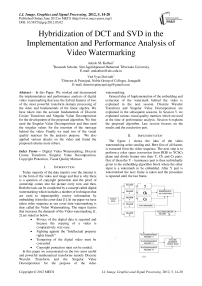Hybridization of DCT and SVD in the Implementation and Performance Analysis of Video Watermarking
Автор: Ashish M. Kothari, Ved Vyas Dwivedi
Журнал: International Journal of Image, Graphics and Signal Processing(IJIGSP) @ijigsp
Статья в выпуске: 5 vol.4, 2012 года.
Бесплатный доступ
In this Paper, We worked and documented the implementation and performance analysis of digital video watermarking that uses the hybrid features of two of the most powerful transform domain processing of the video and fundamentals of the linear algebra. We have taken into the account fundamentals of Discrete Cosine Transform and Singular Value Decomposition for the development of the proposed algorithm. We first used the Singular Value Decomposition and then used the singular values for the insertion of the message behind the video. Finally we used two of the visual quality matrices for the analysis purpose. We also applied various attacks on the video and found the proposed scheme more robust.
Digital Video Watermarking, Discrete Cosine Transform, Singular Value Decomposition, Copyright Protection, Visual Quality Matrices
Короткий адрес: https://sciup.org/15012297
IDR: 15012297
Текст научной статьи Hybridization of DCT and SVD in the Implementation and Performance Analysis of Video Watermarking
Today majority of the data transfer over the internet is in the form of the video and image and that is why there is a question of copyright protection and the proof of ownership comes into the picture every now and then. Both the task can be completed by a concept called digital watermarking which includes a number of techniques that are used to imperceptibly convey information by embedding it into the cover data [1]. In our paper we have taken video sequence as our cover data watermarking is thus called the Video Watermarking. The major factors that increases the demands of the Video watermarking [1, 2] are stated as below.
-
• Privacy of the digital data is required and because the copying of a video is comparatively very easy.
-
• Fighting against the “Intellectual property rights breach”
-
• Tempering of the digital video must be concealed.
-
• Copyright protection must not be eroded.
In this paper we concentrated on the two most useful and powerful mathematical transforms namely Discrete Wavelet Transform and the Singular Value Decomposition for the purpose of the video watermarking.
General idea of Implementation of the embedding and extraction of the watermark behind the video is explained in the next session. Discrete Wavelet Transform and Singular Value Decomposition are explained in the subsequent sessions. In Session 5, we explained various visual quality matrices which are used at the time of performance analysis. Session 6 explains the proposed algorithm. Last session focuses on the results and the conclusion part.
-
II. Implementation
The figure 1 shows the idea of the video watermarking at the sending end. Here first of all frames is extracted from the video sequence. The next step is to perform a color space conversion from RGB to YCbCr plane and divide frames into their Y, Cb and Cr parts. Out of them the Y - luminance part is then individually given to the embedding algorithm block where the other input is a watermark to be embedded. After Y part is watermarked the next frame is taken and the procedure is repeated until the last frame.

(a)
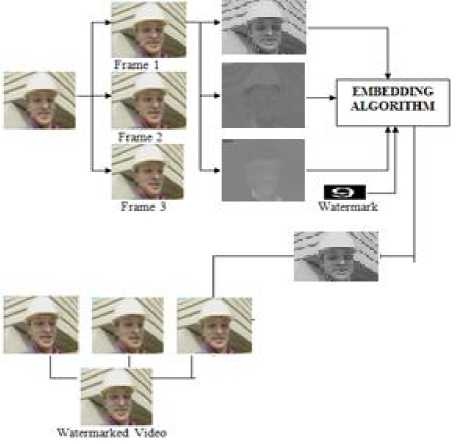
(b)
Figure 1. Idea of Video watermarking - Embedding a watermark
III. Discrete Cosine Transform
Discrete cosine transformation [4, 5, 6] (DCT) transforms a signal from the spatial into the frequency domain by using the cosine waveform. DCT concentrates the information energy in the bands with low frequency, and therefore shows its popularity in digital watermarking techniques. The DCT allows a frame to be broken up into different frequency bands, making it much easier to embed watermarking information into the middle frequency bands of a frame. The middle frequency bands are chosen such that they have minimize to avoid the most visual important parts of the frame (low frequencies) without over-exposing themselves to removal through compression and noise attacks (high frequencies).
Two dimensional DCT of a frame with size MxN and its inverse DCT (IDCT) are defined in Equations 1 and 2, respectively.
F (u,v) =
a (u)»^)!"^ 2JtoW,y)
cos
(2 x + 1) u ■ n
2 ■ M
cos
After the watermark is embedded in every frame, all frames are mixed to make the watermarked video which
(2 y + 1) v ■ n
2 ■ ^
is then transmitted in the channel.
The figure 2 shows the idea of the video watermarking at the receiver end. Here watermarked video is divided into the frames. Color space conversion is performed to have y, Cb and Cr parts from which Y part is selected and the watermark is extracted. This Procedure is repeated for all frames so as to recover all watermarks.
Where a(u) = ^1/M a (u) = ^2/M a (v) = J1/N a (v) = V2/N f (X,y) =
IS 2S a(u)«(r)F(u,r)
for u=0;
for u=1,2,3, for v=0;
for v=1,2,3,
.M-1;
.N-1;
cos
(2 x + 1) u ■ n 2 ■ M
cos
(2 y + 1) v ■ n 2 ■ ^
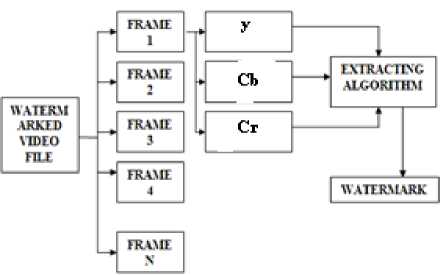
(a)
Where x = 0,1,2,……..M-1, y = 0,1,2,……..N-1
Figure 3(a) shows the three regions in the frequency domain. F L is used to denote the lowest frequency components of the block, while F H is used to denote the higher frequency components. F M is chosen as the embedding region as to provide additional resistance to lossy compression techniques, while avoiding significant modification of the cover video.
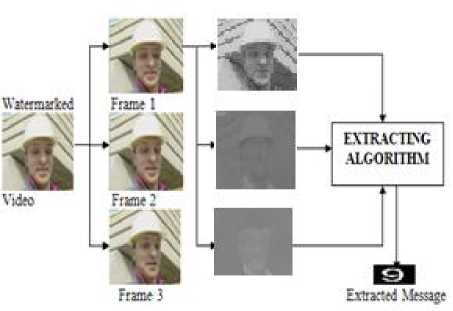
(b)
Figure 2. Idea of Video watermarking - Extracting a watermark
|
Fl |
Fl |
Fl |
Fm |
Fm |
Fm |
Fm |
Fh |
16 |
11 |
10 |
26 |
24 |
40 |
51 |
61 |
|
Ft |
Ft |
Fm |
Fm |
Fm |
Fm |
Fh |
Fh |
12 |
12 |
14 |
19 |
26 |
58 |
60 |
55 |
|
Fl |
Fm |
Fm |
Fm |
Fm |
Fh |
Fh |
Fh |
1J |
13 |
16 |
24 |
40 |
57 |
69 |
56 |
|
Fm |
Fm |
Fm |
Fm |
Fh |
Fh |
Fh |
Fh |
14 |
17 |
22 |
29 |
51 |
87 |
80 |
62 |
|
Fm |
Fm |
Fm |
Fh |
Fh |
Fh |
Fh |
Fh |
1Б |
22 |
37 |
56 |
68 |
109 |
103 |
|
|
Fm |
Fm |
Fh |
Fh |
Fh |
Fh |
Fh |
Fh |
24 |
35 |
55 |
64 |
81 |
104 |
113 |
92 |
|
Fm |
Fh |
Fh |
Fh |
Fh |
Fh |
Fh |
Fh |
49 |
64 |
7S |
87 |
103 |
121 |
120 |
101 |
|
Fh |
Fh |
Fh |
Fh |
Fh |
Fh |
Fh |
Fh |
72 |
92 |
95 |
9S |
112 |
100 |
103 |
99 |
(a) (b)
Figure 3. Defination of DCT regiouns and Quantization values used in JPEG compression scheme[3]
IV. Singular Value Decomposition
Singular value decomposition (SVD) [7-11] is a numerical technique based on the linear algebra and it is used to diagonalize matrices in numerical analysis. It is an algorithm developed for a variety of applications.
When we apply SVD to an Image A of size MxN, we find three matrices, namely U, V and S whose properties are:
-
• We can represent A = USVT.
-
• U and V matrices are called Unitary matrices having size MxM and NxN respectively.
-
• S matrix is called diagonal matrix having size MxN.
-
• The columns of the U matrix are called the left singular vectors while the columns of the V matrix are called the right singular vectors of A.
-
• The diagonal entries of S are called the singular values of A and are arranged in decreasing order
-
• The singular values (SVs) of an image have very good stability, i.e., when a small perturbation is added to an image, its SVs do not change significantly;
-
• SVD [12, 13] is able to efficiently represent the intrinsic algebraic properties of an image, where singular values correspond to the brightness of the image and singular vectors reflect geometry characteristics of the image.
-
• An image matrix has many small singular values compared with the first singular value. Even ignoring these small singular values in the reconstruction of the image does not affect the quality of the reconstructed image [13].
An Example of the Singular Value decomposition is given as follows.
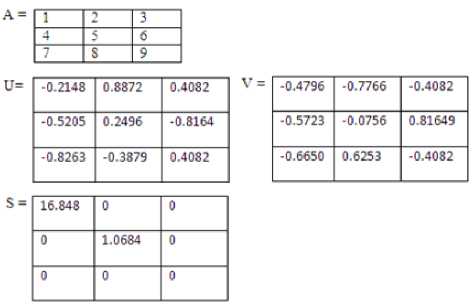
-
V. Visual quality Matrices
We have mainly used the following visual quality matrices [14] for the sake of comparison of degradation after the watermark is added to video.
M N
MSE=M1×Ν∑∑{(f(x,y)-f (x, y))^2} х=1 у=1
ΡЅΝR = 10 ×log og MSE
Here MSE – Mean Square Error
PSNR – Peak Signal to noise Ratio f(x,y) – Original Frame of the video f’(x,y) – Watermarked Frame of the Video.
The phrase peak signal-to-noise ratio
, often
abbreviated PSNR, is an engineering term for the ratio between the maximum possible power of a signal and the power of corrupting noise that affects the fidelity of its representation. Because many signals have a very wide dynamic range, PSNR is usually expressed in terms of the logarithmic decibel scale. A higher PSNR would normally indicate that the reconstruction is of higher quality at the receiver end.
PSNR is most easily defined via the Mean Square Error (MSE) which for two m×n Frame f and f’ where one of the Frames is considered a noisy approximation of the other.
-
VI. Proposed Algorithm
In our proposed algorithm we have taken the foreman video as shown in the figure 4 and we have taken the message to be embedded as shown in the figure 5.

Figure 4. Original Video
Riya
-
Figure 5. Message to be embedded
-
A. Embedding Algorithm
Following is the stepwise representation of what we have done for the video watermarking using the proposed algorithm.
-
1. First of all the video is decomposed into the no. of frames.
-
2. Color space conversion is performed to have Y frame.
-
3. Divide the frame into the number of blocks.
-
4. Read the message and apply SVD to the message.
-
5. Take the Singular values of the SVD matrices for the embedding purpose.
-
6. Apply DCT to the original frame and then embed the singular values obtained in the previous step in the DC part of the DCT.
-
7. Apply Inverse DCT to obtain the watermarked frame.
-
8. Repeat step 2 to 7 for every frame.
-
9. Combine every watermarked frame to obtain watermarked video.
Figure 6 shows the watermarked video sequence.

Figure 6. Watermarked Video
Following Table shows the results of the proposed scheme.
T able .1 O btained PSNR and MSE values for first five frames
|
Frame No. |
PSNR(DB) |
MSE |
Correlation |
|
1 |
41.9171 |
11.9648 |
0.9982 |
|
2 |
41.9171 |
11.9648 |
0.9982 |
|
3 |
41.8429 |
12.1444 |
0.9974 |
|
4 |
41.8429 |
12.1444 |
0.9974 |
|
5 |
42.0171 |
11.5648 |
0.9986 |
-
B. Extraction Algorithm
We followed following steps to obtain the message back from the watermarked video sequence.
-
1. First of all the video is decomposed into the no. of frames.
-
2. Color space conversion is performed to have Y frame.
-
3. Divide the frame into the number of blocks.
-
4. Apply DCT to the watermarked frame.
-
5. Obtain the singular values from the blocks.
-
6. Apply inverse SVD to find out the watermark bits.
-
7. Repeat steps 2 to 5 for extracting the watermarks from all the frames.
Following are the extraction results what we got from Y frame without attack.

Riya 8110
(b)

(c)
Figure 8. Watermarked Frame and messages extracted under compression attack with (a) CQ = 95 (b) CQ = 60 (c) CQ = 40
-
B. Gaussian LPF Attack
Table 3 shows the results of Gaussian LPF with a mask size of 3x3 and various sigma.
T able .3 O btained R esults under G aussian LPF attack
Riya 8110
Figure 7. Message Extracted from Y Frame without any attack
-
VII. Results
We applied various attacks on the video and found various results as discussed below.
-
A. Compression Attack
We passed the video from the jpeg compression attack and achieved results as shown in the table 2.
T able .2 O btained R esults under compression attack
Cq = 95 Cq = 60 Cq = 40
PSNR(dB) 39.0153 33.165 29.1974
MSE 27.3959 99.3629 239.1273
Correlation 0.99837 0.98957 0.681
Riya 8110

(a)
PSNR(dB) MSE
Correlation
Sigma = 0.5 34.4421 64.7254 0.96338
Sigma = 2 27.2207 333.9381 0.83254
Sigma = 3.5 27.0077 350.4674 0.8129
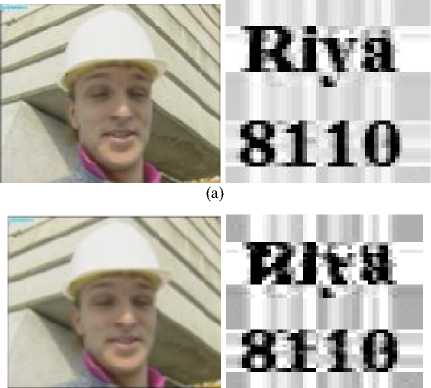

Figure 9. Watermarked Frame and messages extracted under gaussian LPF attack with (a) sigma = 0.5 (b) sigma = 2 (c) sigma = 3.5
C. Gaussian Noise Attack
We added Gaussian noise with 0 mean various variances as described in the table 4.
T able .4 O btained R esults under G aussian N oise attack
|
Variance = 0.0005 |
Variance = 0.005 |
|
|
PSNR(dB) |
39.0153 |
33.165 |
|
MSE |
27.3959 |
99.3629 |
|
Correlation |
0.99837 |
0.98957 |
Variance = 0.01
29.1974
239.1273 0.681


(b)
Шуй8110
(a)
Шуй8110
Rn ii
8 И О
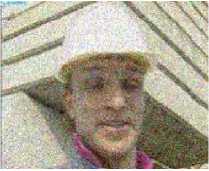
(c)
Figure 10. Watermarked Frame and messages extracted under gaussian noise attack with Variance (a) 0.0005 (b) 0.005 (c) 0.01
- 25.1839 544.5258
T able .5 O btained R esults under S alt & P epper N oise attack
Variance = 0.005
PSNR(dB) 27.8514
MSE 288.5032
Variance = 0.009
Variance = 0.01
24.5486
626.8943
Correlation 0.9882
0.92281 0.92202

(a)
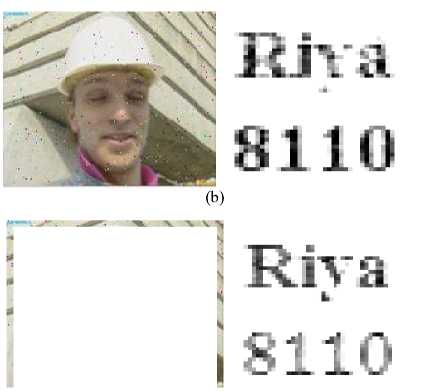
(c)

-
E. Spackle NoiseAttack
26.0079
421.7581
0.98259
We applied Spackle noise attack to the frame with various variances and taken results which appears in table 6.
T able .6 O btained R esults under S packle N oise attack
PSNR(dB) MSE
Correlation
Variance = 0.005
Variance = 0.009 23.5772 736.2925 0.93392
Variance = 0.01
23.1421
814.2854
0.88243

(a)

(b)

(c)
Figure 12. Watermarked Frame and messages extracted under spackle noise attack with Variance (a) 0.0005 (b) 0.009 (c) 0.01
RHa
-
VIII. Conclusion
Список литературы Hybridization of DCT and SVD in the Implementation and Performance Analysis of Video Watermarking
- Debnath Bhattacharyya. "Watermarking Using Multiresolution Cosine Transformation: A Review", Communications in Computer and Information Science, 2011.
- Huang D., Liu J., Huang J., "A DWT-based image watermarking algorithm", Proc. IEEE Intl. Conf. Multimedia and Expo., pp.429– 432, 2001.
- Chiou-Ting Hsu and Ja-Ling Wu, "DCT-BASED WATERMARKING FOR VIDEO", IEEE Transactions on Consumer Electronics, Vol. 44, No. 1, FEBRUARY 1998
- E. Koch and J. Zhao, "Towards Robust and Hidden Image Copyright Labeling," Proc. IEEE Nonlinear Signal and Image Processing, pp. 452-455, June 1995.
- C. T. Hsu and J. L. Wu, "Hidden Signatures in Images," Proceeding of International Conference on Image Processing, pp. 223-226, Sep. 1996.
- I. J. Cox, J. Kilian, T. Leighton and T. Shamoon, "Secure Spread Spectrum Watermarking for Multimedia," Tech. Rep. 95-1 0, NEC Research Institute, 1995.
- H. C. Andrews and C. L. Patterson, "Singular Value Decomposition (SVD) image coding" IEEE Trans. on Communications, pp. 425-432, April 1976.
- G. H. Golub and C. Reinsch, "Singular value decomposition and least squares solutions", Numer. Math., Vol. 14, pp. 403-420, 1970.
- Liu, R., and T. Tan, 2002. "A SVD-Based Watermarking Scheme for Protecting Rightful Ownership", IEEE Trans. Multimedia 4, pp.121-128.
- Chang, C., P.Tsai, and C. Lin, 2005. "SVD-based digital image watermarking scheme", Pattern Recognition Letters 26, pp.1577-1586.
- Wu, Y, 2005. "On the Security of SVD-Based Ownership Watermarking", IEEE Trans. Multimedia 7, pp. 624-627.
- Ke-feng he, et al , "Watermarking for images using the HVS and SVD in the wavelet domain" Proceedings of IEEE International Conference on Mechatronics and Automation, pp.2352- 2356, 2006
- V.Santhi and Dr. Arunkumar Thangavelu, "DWT-SVD Combined Full Band Robust Watermarking Technique for Color Images in YUV Color Space", International Journal of Computer Theory and Engineering, Vol. 1, No. 4, October2009.
- M. Kutter & F.A.P.Petitcolas, "A fair benchmark for image watermarking systems", Electronic Imaging '99. Security and Watermarking of Multimedia Contents, vol. 3657, Sans Jose, CA, USA, 25-27 January 1999.
- Web page http://en.wikipedia.org/wiki/Peak_signal-to-noise_ratio

